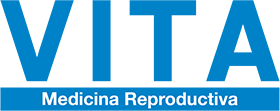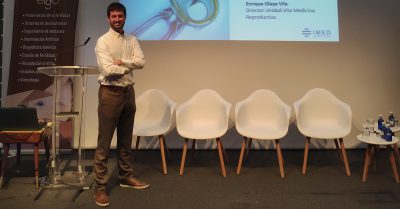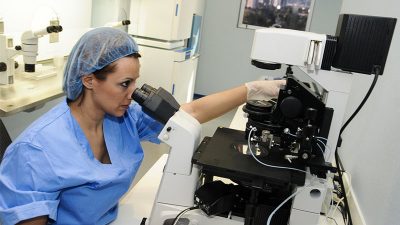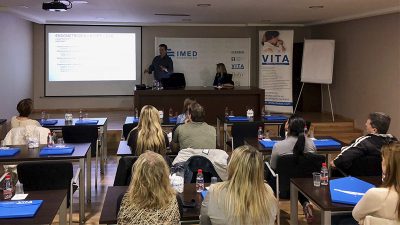In Vitro Fertilisation with donor sperm

In vitro fertilization (IVF) with donor sperm is a technique by which the oocytes, once extracted by follicular puncture, are fertilized in the laboratory by the sperm of a carefully selected anonymous donor. Those that are fertilized correctly are monitored for several days until the best quality embryos are transferred to the maternal uterus. It is the most widely used assisted reproduction technique, thanks to its high pregnancy rates.
What is In Vitro Fertilisation (IVF) with donor sperm?
Treatment begins with ovarian stimulation. The day the period begins, your patient assistant will be notified, they will schedule the dates of the injections and the exact medication dose (following the gynecologist’s instructions). The ovaries are stimulated with hormones similar to those produced by the woman herself.
About 5 or 6 days after starting the medication, ultrasound scan controls will be performed to monitor the growth of the follicles in the ovaries. These controls will be repeated periodically until the follicles reach the appropriate size.
Once several follicles have reached the appropriate size (18 mm in diameter), the hCG (human Chorionic Gonadotropin) hormone is administered to trigger the final maturation of the oocytes, which will occur 34-36 hours later. That is when the follicular puncture will be performed.
When a sufficient number of oocytes is obtained, follicular puncture is performed. The patient is sedated and in the operating theater the fertility specialist extracts the mature oocytes, aspirating their fluid with a very fine needle under transvaginal ultrasound guidance.
It is a minimally invasive and quick intervention, where the patient will be sedated for approximately 10-15 minutes, and will immediately be able to return to her activity.
Once the oocytes have been retrieved, the seminal capacitation of an anonymous donor sperm will be performed after the thawing of a sperm bank-obtained sample.
The semen sample is selected in the laboratory using washing techniques where the highest mobility sperm will be selected.
The VITA biomedical team will decide, based on the history and characteristics of the patient, which insemination technique (IVF or ICSI) is the most appropriate.
Through conventional IVF, the retrieved oocytes and the capacitated spermatozoa are brought into contact in a laboratory dish, and one of them is expected to fertilise the oocyte autonomously.
Through ICSI (intracytoplasmic sperm injection), in the laboratory the embryologist directly introduces a selected spermatozoon from the semen sample into each oocyte with the help of a micromanipulator and a microneedle.
The day after the insemination, the fertilisation of the oocytes occurs. Those that have been correctly fertilised will be kept under observation in the laboratory, where day by day the embryos will divide and increase their number of cells.
The resulting embryos with the appropriate morphological characteristics will be the ones that are transferred to the maternal uterus. The surplus of embryos will be frozen using cryopreservation techniques.
The gynaecologist will use a small catheter to guide the embryos through the cervix and into the uterus. The embryo transfer procedure lasts a few minutes and patient recovery time is minimal.
To facilitate embryo implantation, progesterone is administered into the vagina to support the luteal phase.
The pregnancy test will be carried out by means of a blood test 13 days after the follicular puncture.
If the patient experiences bleeding before the test, it is important that she never stops taking the medication and that seeks advice from the medical team.
Throughout the in vitro fertilization treatment, her personal assistant will be available at all times to answer any questions she may have and support her in this very special moment.
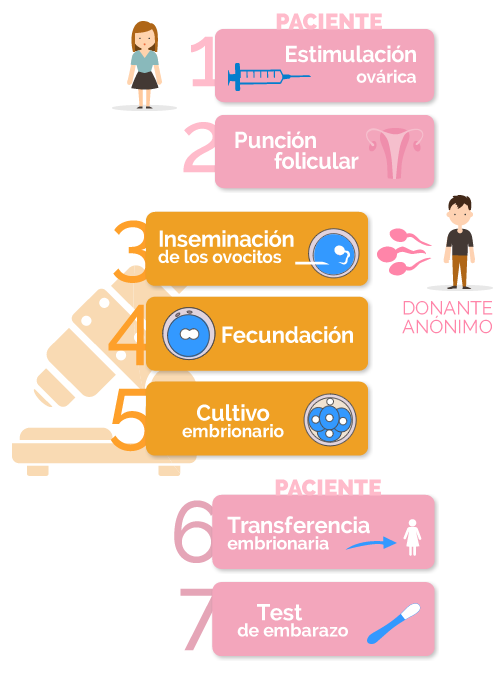
For whom is this technique indicated?
In Vitro Fertilisation with donor sperm (heterologous IVF) is indicated for
- Couples where the man has severe male factor infertility, with poor sperm quality or azoospermia.
- Couples where the man is the carrier of a genetic disease that cannot be diagnosed by PGD (Preimplantation Genetic Diagnosis).
- Couples where there is suspicion of poor embryo quality or repeated implantation failures due to a male factor infertility as the main cause.
- Couples who have failed prior In Vitro Fertilisation with the partner’s semen.
- Women without a male partner who want to get pregnant and be single mothers
- Couples of homosexual women.
The requirements for a couple to undergo in vitro fertilization and have the best chance of success are:
- The use of an ultrasound scan to rule out possible uterine malformations that could affect the implantation and development of the pregnancy. In addition, to guarantee a response to ovarian stimulation to recover a minimum of oocytes suitable for the performance of the technique.
- To select a semen sample from an anonymous donor bank with adequate count and motility parameters, selected with a “Donor Screening” protocol that detects autosomal recessive genetic diseases.
Where do sperm donors come from?
Semen donors, according to the Spanish legislation on donations, must meet certain requirements. They must be between 18 and 35 years old, in good mental and physical health, have good semen quality and not suffer from any genetic or sexually transmitted disease.
VITA uses the CEIFER sperm donor bank, whose donors go through a strict and exhaustive examination in order to guarantee the quality of the treatments. The donor will undergo various tests and studies, such as a first medical evaluation, a psychological test, a study of the sperm quality, a genetic study and a study of infectious diseases, sexually transmitted diseases, etc.
All sperm donors go through the “Donor Screening“, a Study of Autosomal Recessive Genetic Diseases Carriers. Through this test it is possible to detect the most common autosomal recessive genetic diseases. In addition, when the time comes to assign the donor, a “Genetic Matching” protocol is followed, so that the donor and the patient do not share mutations in the same genes.

